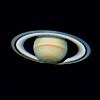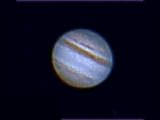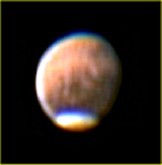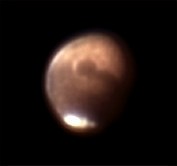Planetary images from the back yard
(Meade LX-200 10" f/10 scope, Flip-mirror, 2x Barlow, ToUcam Webcam)
|
Saturn - 4 Oct 03 ToUcam Webcam - Best 1000 out of 2320 frames selected then processed in Registax |
||||
 Saturn - 25 Dec 03 ToUcam Webcam - Best 200 out of 1000 frames selected in HandyAvi then processed in Registax |
 Jupiter - 25 Dec 03 ToUcam Webcam - Best 200 out of 1000 frames selected in HandyAvi then processed in Registax |
Jupiter - 10 Mar 04
showing new "blue band". Thought it was a problem at first and
tried to process it away but Google search indicates it appears to be
real. ToUcam
Webcam - Best 200 out of 1000 frames selected in HandyAvi then
processed in Registax |
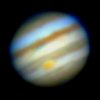 Jupiter - 26 Mar 04 - 2250 Shows
the "Great Red Spot" which looks gold these days? This is one
frame from the movie in the next table item. |
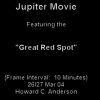 Jupiter Movie 26/27 March 04 Shows the Great Red Spot as
Jupiter rotates. The time between each movie frame is 10
minutes. Each Jupiter image frame displays for 1/2 second.
So this is just 20 times real-time. Jupiter rotates FAST.
One revolution every 9.9 hours! The movie contains additional
noise due to GIF compression (The good news is that the movie is 10
times smaller than it would otherwise have been...) |
 Triple Moon Shadow Event 28 Mar 04 - 0106 Hrs If I am correct the numbers
designate the following:
1. Shadow of Ganymede, 2. Shadow of Io, 3. Shadow of Callisto, 4. Ganymede itself. Just to the left of Ganymedeis Io but it not visible in this image since it is not significantly brighter or dimmer than Jupiter. |
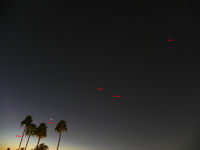 Planetary Alignment 27 January 2016. I was able to get Mercury, Venus, Saturn, and Mars. Jupiter was high to the right and out of the frame... Darn... :-) |
JUPITER MOVIE (25 Sep 2010)
Click on the image below to see the movie in your default video display program...
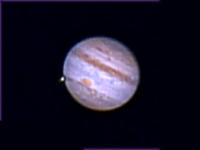
JUPITER MOVIE Gif Image
The moon Ganymede crosses Jupiter on 25 Sep 2010.
Ganymede is pretty big and so is its shadow...
Click on the image to see the full-size movie in your
default video display program...
We used a Meade LX-200 10" f/10 telescope and a 2x Barlow lens.
We used HandyAvi and a ToUcam webcam to create a 500 frame AVI movie every 5 minutes.
Each AVI file was then processed using RegiStax to produce each single JPG frame of the movie.
HandyAvi was then used to create the movie from the JPG images.
The images degraded as Jupiter sunk toward the horizon.
We used a Temperature-Compensated Focuser to maintain focus of the telescope throughout the night.Everything was automated.
We used HandyAvi to automatically keep Jupiter centered in the telescope and to automatically take 500 frames every 5 minutes. We set it up then went to bed... :-)
CCD Mars
Images taken with ToUcam
Webcam
Mars Movie one full rotation:
Updated on 8 September 2003 with additional frames from my back yard subsequent to the frames obtained on an expedition to the Flagstaff area. (See "Star-Crossed Mars Expedition" for a description the trials and tribulations associated with this expedition...) The Mars movie is derived from frames taken 10, 16, 17, from my back yard, 29, and 30 August from the Flagstaff area, and 7 September from my back yard. I have finally succeeded in my goal to obtain one complete rotation. Note that the above is essentially a time-lapse movie where a half hour (approximately) elapses between each frame. The quality of the image varies greatly with the "seeing" or atmospheric distortion conditions. The 7 September frames are not as good as the ones obtained from the Flagstaff area in part due to the difference in elevation between the two sites - 1100 feet here in Tempe versus 7000 feet at the Flagstaff area site (- less atmosphere between the telescope and Mars in Flagstaff thus yielding better images).
Note that some of the frames (particularly frames 25 and 30) show morning haze and or clouds on the left edge of Mars and some of the frames (25 and 26) show a cloud near the right edge of Mars. As time permits, I will reprocess some of these frames to bring out more of the detail. This movie was a multi-day job due to the processing involved so refinements will have to wait... Lots of additional work to extend the movie after the Flagstaff trip and the 7 September back yard work. In addition, I modified my image processing software to solve the problem of the blue and red artifacts produced by the ToUcam webcam. It took many hours for Registax to process the images. Each frame above is the result of aligning and averaging 1000 webcam images. So in all, 49,000 ToUcam frames were processed to produce the movie.
Anyway, the above, when compared with the below, indicates increased understanding on my part but also the fact that Mars is closer now and imaging is much easier. We are able to resolve some real surface detail now with a 10" telescope.
Earlier images - When Mars was farther away:
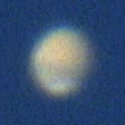 7 Jun 03 gif movie of source frames for
previous image. The movie illustrates the seeing conditions from my
back yard on 7 Jun
03.
About
the ToUcam |
||
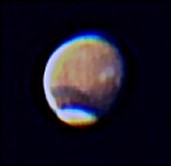 Mars 11 Jun 03 ~ 0400 Local - 2x Barlow Note three clouds over the Tharsis region. |
Mars 17 Jun 03 ~ 0400 Local - 2x
Barlow |
Mars 27 Jun 03 ~ 0400 Local - 2x
Barlow |
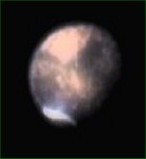 Mars 03 July 03 ~ 0400 Local - 2x Barlow |
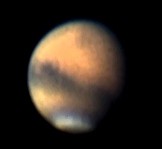 Mars 12 July 02 ~ 0400 Local - 5x Barlow |
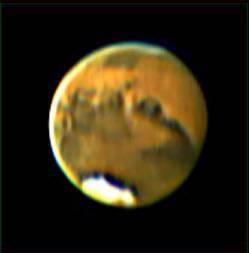 Mars 31 July ~ 0230 Local - 2x Barlow - Magnified for display here. |
Notes on Mars Images
The Mars Movie shown in the first cell above was done by capturing 1000
frames with the ToUcam webcam at half-hour intervals. Frames were
taken at 10 frames per second. 100 seconds of capture gives 1000
frames. "Avid", a program I wrote over the last couple of weeks
was then used to crop the AVI frames automatically to 250 by 250 pixels
so as to reduce the lengthy run-time of Registax which centers,
averages, "stacks" the frames to yield an "averaged" image which is
far, far, better than any one of the original frames. Registax
was used to create each of the 19 frames of the movie. The movie
was created using JASC's Animation Shop 3 which is part of the Paint
Shop Pro package. For me, one of the good things about the
movie is that it pretty much verifies that the detail being imaged is
pretty much "true". With a still frame, one wonders if the image
is all "real" or whether some things might be accidentally introduced
artifacts. Along that line, there are some artifacts in the movie
that should not be there. The blue area above Mars is somehow
artifically induced I believe but I did not eliminate it because I
wanted to show exactly what the camera captured insofar as that is
possible.
I started using the ToUcam because of a wonderful Article by Michael
Davis and David Staup entitled "Shooting
the Planets with Webcams" appeared in the June 2003 issue of Sky &
Telescope. The article described the Philips ToUcam Pro camera,
where to get an eyepiece adapter, and where to get free software for
stacking
and processing the images contained in the ".avi" movie files produced
by the camera. I ordered the camera and the adapter on-line.
Was
finally able to use them this week (7 Jun 03).
I used a flip mirror system to initially center the image then used my
advanced Meade telescope controls in ImCap (the program I wrote
originally for doing ST-4 Image Capture) to further center the
image and remotely focus using the stepper motor focuser I designed and
built recently.
I then adjusted the image contrast, frames per second, shutter speed,
etc., using the ToUcam control software then captured a movie.
Several movies actually of about 500 to 1000 frames each.
Turns into LOTS of megabytes in a hurry so that is something to
take into account. The cool thing is I can actually watch the
camera images in real-time at
25 frames per second even while capturing the images.
I then used Registax, freeware mentioned in the article, to stack the
frames from the best movie to produce the still image of Mars.
To produce the GIF movies, I used the JASC Animation Workshop which is
part of the Paint Shop Pro series of image processing tools. I
cropped the images to reduce the size of the movie and show just Mars
without a lot of "dead space" around it. Then I saved the result
as
a GIF image which plays as if it were a movie.
The 7 Jun 03 Mars movie that you see looks exactly like what I was
seeing during
capture. Mars is dancing all about and even "shape-shifting".
Registax was able to pull a pretty decent image out of that mess I
think.
All-in-all, this was a lot of fun and produced better planetary
images than I have been able to get so far with my ST-7E camera.
Mars' closest approach was on 27 August 2003.



